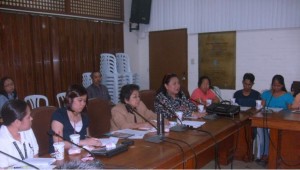 Part 2 of a series of articles by Jonathan Monis, from the Youth Consortium for the Passage of the RH Bill.
Part 2 of a series of articles by Jonathan Monis, from the Youth Consortium for the Passage of the RH Bill.
Read Part 1 here.
“In the last 200 years the population of our planet has grown exponentially, at a rate of 1.9% per year. If it continued at this rate, with the population doubling every 40 years, by 2600 we would all be standing literally shoulder to shoulder.”
– Stephen Hawking
One of the culprits of the Philippines’ failure to attain MDG 5 is the lack of comprehensive national policy for safe motherhood and reproductive health. Such a policy would ensure favorable political and programmatic environment. It would also guarantee resources.
For instance, the Republic Act No. 9710, or An Act Providing Magna Carta of Women, is legislated to ensure the human rights of women. It is the government abiding with several international agreements such as CEDAW, ICPD and of course the MDGs. Because of the Magna Carta of Women, the State is tasked to accelerate the participation and equitable representation of women. Women should not only be agents and beneficiaries of development, but also be part of decision-making and policy-making processes in both public and private entities; this is aligned with the achievement of MDG 3 or the Promotion of Gender Equality and Empower Women.
There are national and local policies on Reproductive Health and Safe Motherhood. Just last year, the DOH has passed the Administrative Order No. 2010-0014, or Administration of Life-Saving Drugs and Medicine by Midwives to Rapidly Reduce Maternal and Neonatal Morbidity and Mortality. The Maternal, Newborn and Child Health and Nutrition (MNCHN) strategies for the succeeding years are in accordance with this and other Administrative Orders. This AO was created in efforts to fast track the reduction of maternal deaths.
At the local level, there are some cities and municipalities that passed local codes related to RH and Maternal Health. Olongapo City is considered one of the more progressive cities outside Metro Manila because of programs and policies related to human development. It was the first city to pass an RH Code in 2007. It provides an annual budget of P3 million for RH information and services. The Code was further strengthened by the passage of another ordinance encouraging facility-based delivery among pregnant women.
On the other hand, there are local ordinances that impede the progress of RH in the country. Executive Order No. 003 was issued by former Mayor Lito Atienza in Manila City. The E.O. ordered all city-funded clinics and hospitals to promote natural family planning as the sole family planning method. Moreover, Brgy. Ayala Alabang proposed an Anti-RH Ordinance, in which it banned pills and sanctioned the sale of condoms without prescriptions. Seven barangays as well in Balanga, Bataan, followed the example of Brgy. Ayala Alabang. However, it was all dismissed through the efforts of RH advocates.

Commission on Human Rights (CHR) Chairperson Loretta “Etta” Rosales hears the case of the pauper petitioners VS Mayor Lito Atienza's EO No. 003. (Photo from http://reprocen.com/CHR-OSIL.pdf)
Although there are local and national policies in place, there is still a need for a comprehensive and stronger policy that will define and mandate different agencies and other stakeholders to implement cohesive strategies for safe motherhood and reproductive health.
The Reproductive Health Bill has been pending for more than a decade in Congress. It could contribute drastically to the achievement of MDG 5 through its scientifically proven provisions, if only it is translated into policy.
RH Bill includes safe motherhood service provisions and facilities. It will also include mechanisms improvement such as the establishment of Emergency and Comprehensive Emergency Obstetric and Neonatal Care (EmONC and CEmONC), which will cater to high-risk and complicated pregnancies. The RH Bill also includes a more systematic referral and procurement processing of contraceptives and other RH commodities. Mobile clinics, in which other health services are included, will ensure that health services are within reach especially to those living in far-flung areas. All Local Government Units, government hospitals, and other public health facilities shall conduct an annual Maternal Death Review in accordance with the guidelines set by the DOH in order to track progress of the programs and maternal health status.
To ensure universal access to sexual and reproductive health services, health staff at the barangay level—particularly the Barangay Health Workers—will be capacitated to strengthen FP service provision and education at the community level. In addition, accredited health facilities shall provide all the family planning services including modern contraceptives and pregnancy-related services. The expenses of the poor shall be covered by PhilHealth or government financial assistance.
If the RH Bill had been legislated years ago, we would have seen huge improvement on the MDG 5 statistical figures. Now we have less than 3 years to o till the deadline, and even if the RH Bill is passed by this year, it’s very unlikely we can achieve the targets.
The last part of this article series will be about advocacy and constructive engagement. It will lay down the importance of advocacy in achieving MDG 5.
Sources:
Philippines Progress Report on the Millennium Development Goals 2010
Where We Are – Olongapo. United Nations Populations Fund website.retrieved01 February2012. http://philippines.unfpa.org/un_content.php?uID=8
CHR backs pauper litigants vs. Manila contraceptive ban. Reprocen.com. retrieved 01 February 2012. http://reprocen.com/CHR-OSIL.pdf
MNCHN Strategy and Operations. Department of Health website. Retrieved 02 February 2012.

One Comment on ““The Need for a Comprehensive National Policy on Women’s Health””
Pingback: The Status of MDG 5 in the Philippines | Mulat Pinoy